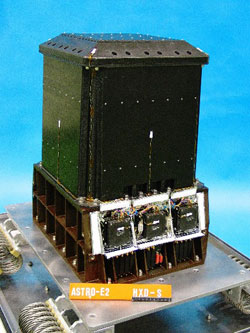X-ray Detectors - Optical Light Detections
X-ray Detectors
Seeing X-rays with Optical Light
In some materials, the energy of the incoming X-rays is converted into visible light. Detectors are designed from these materials by attaching photomultiplier tubes to read the flash of visible light.
Scintillation Detectors
Scintillators work by converting X-ray energy into visible light. The energy of the incoming X-ray is completely absorbed by the material, exciting a molecule of the detector material. When the molecule de-excites, it emits a pulse of light, this time in the optical region of the electromagnetic spectrum. So, in this way, the incoming X-ray has been converted to optical light.

Photo of the Hard X-ray Detector before it was installed on the Suzaku satellite. (Credit: JAXA/ISAS and NASA)
The alkali halides NaI and CsI, activated by a small amount of either thallium or sodium impurity, have been the scintillators of choice so far in X-ray astronomy. This has been true because these materials can be made into large area crystals, have good X-ray stopping power, and are efficient light producers.
Phosphor Detectors
We distinguish scintillators from phosphors, at least in X-ray astronomy, by defining bulk crystalline materials such as NaI and CsI as scintillators, and thin granular layers of rare earth oxysulphides as phosphors.
The physics of X-ray conversion for phosphors is essentially the same as described for scintillators. Also, the key functional elements of any phosphor-based detector are the same as for a scintillator. For astronomy, the similarities end there. While large area single crystals of NaI and CsI are valued for their stopping power in hard X-ray and gamma-ray astronomy, thin layers of phosphors are used to do high resolution, soft X-ray imaging.
Updated: October 2013

